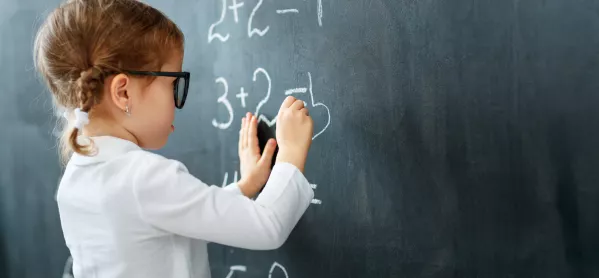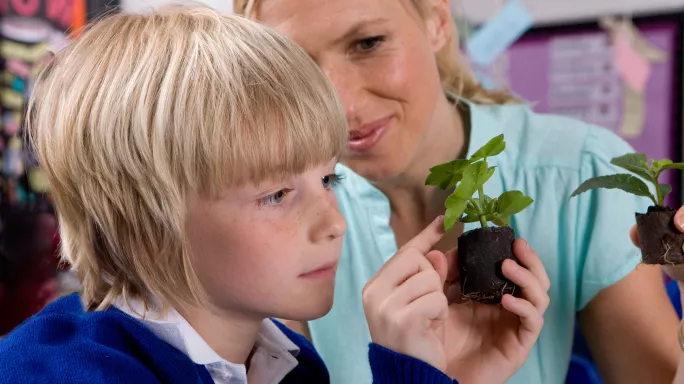
- Home
- EYFS maths: 4 effective ways to teach numeracy
EYFS maths: 4 effective ways to teach numeracy

I’ve seen early maths done really well in schools over the years.
I’ve also come across scenarios in which subject knowledge at this level is not as secure as with other areas of learning.
It may seem to some outside the sector that there is little more to early maths than supporting children with the ability to count effectively and have emerging number knowledge.
Quick read: Three ways to solve the problem of Year 7 maths
Quick listen: What you need to know about early maths teaching
Want to know more? How playing catch could boost pupils’ maths attainment
But before children reach that point in Reception (Development Matters tells us that this is the age at which children should be developing their growing ability to count with some accuracy), there is an entire world of maths that lurks beneath.
There may be a temptation in nursery to try to rush through this phase - after all, Little Johnny arrives aged 3 with the ability to recite numbers to 10. Surely he is ready to put that into action with some counting? Well, no, actually.
Before that point, he needs to develop an understanding of quantity, and if this is skipped over in a bid to rush on to effective counting, we could be in trouble later on at a conceptual level when working with number.
The 30- to 50-month age band for number is concerned largely with quantity. For example: “Compares two groups of objects, saying when they have the same number” and “Knows that numbers identify how many objects are in a set”.
It may surprise some to know that the ability to subitise small quantities comes even earlier on.
If we don’t spend enough time embedding this learning, trying to teach addition and subtraction later in Reception will prove ineffective.

Children must have an understanding of the relationship between numeral and quantity before they begin to combine groups of objects.
It is easy to reduce this ability to a tray of plastic bears and a tick sheet at a table with the teacher.
However, if we are in the business of teaching early maths, this rather dull approach is unnecessary and will not inspire young mathematicians to become independent problem solvers.
For children to truly develop mastery of quantity and number in the early years, teaching needs to be contextual and it needs great adult interactions. So how can we support and teach children maths as they play?
1. Get involved
In her 2010 paper about play and mathematical learning, Helen Williams provides evidence of how adult interactions during play really help: “Adult intervention of differing sorts - playing alongside, adding a prop, work outside the area - linked to observations made of children’s play can fundamentally affect the amount and depth of mathematics engaged in independently.”
Think about how the adults can use the provision to promote mathematical thinking. Beware here, however, the “mood hoover” question: “How many?” Unless you have no idea if a child has the ability to count, this is a low-level question that can suck the life out of creative play.
Instead, ponder, “I wonder what will happen if…” and develop various problems children can solve. “How many” also assumes that children have the preceding mathematical knowledge previously discussed. If you are working with three- or four-year-olds, that is a big assumption.
2. Bring in role play
Use role play to effectively combine maths and play, using situations such as the corner shop, the doctor’s surgery, or anything where they can learn about and apply problems around quantity.
How much do we need? Can I have two? How many more shall we get? Can I have the same? Can you share them between three teddies? The key here is to develop knowledge and problem solving through interactions with adults.
3. Explore outdoors
Use the outdoors to engage with maths in a physical way. I use chalk to mark how far children can jump, or roll, or fly a paper aeroplane.
Measure using footsteps and write the number next to the mark with the child’s name. Who jumped the furthest? Who can beat five? Learning through landscapes offers some great ideas.
4. Turn to fairytales
Stories are a great place to develop mathematical learning.
As well as the obvious Goldilocks and the Three Bears, Three Little Pigs or The Hungry Caterpillar, most stories will contain scenarios in which you can develop children’s problem solving or mathematical thinking.
The National Centre for Excellence in the Teaching of Mathematics (NCETM) says: “Quite often, there is some sort of a problem or crisis in the story and characters use their mathematical knowledge and skills to solve it.
“As children become involved in the narrative and characters, they emotionally invest in understanding the maths.”
Nicky Clements is head of EYFS at Victoria Academies Trust. She tweets @nickyclements71
Register with Tes and you can read five free articles every month, plus you'll have access to our range of award-winning newsletters.
Keep reading for just £4.90 per month
You've reached your limit of free articles this month. Subscribe for £4.90 per month for three months and get:
- Unlimited access to all Tes magazine content
- Exclusive subscriber-only stories
- Award-winning email newsletters
You've reached your limit of free articles this month. Subscribe for £4.90 per month for three months and get:
- Unlimited access to all Tes magazine content
- Exclusive subscriber-only stories
- Award-winning email newsletters



